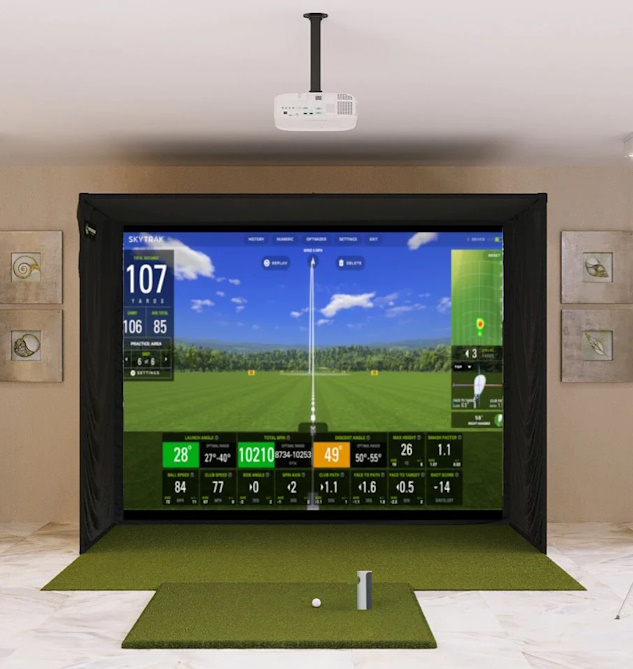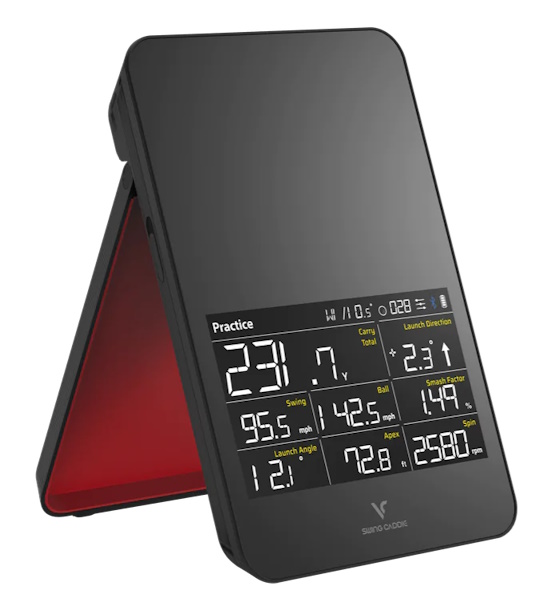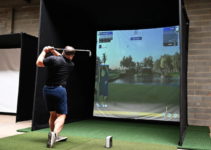Golfstead is reader-supported. When you buy through links on the site, we may earn an affiliate commission at no extra cost to you. Our affiliations include, but are not limited to, the eBay Partner Network and Amazon Associates.

If you think a golf simulator and a launch monitor are the same thing, you would be wrong! They share many similarities, but they are essentially two different things that often serve different purposes.
It’s a common misunderstanding, though, and if you are planning to buy either one of them, it would be best to have a clear idea about what both are exactly.
To help you in this cause, we have come up with all the information you need to understand the differences and similarities.
Golf technology is at its peak. It is introducing a lot of new breakthrough products to the market, with launch monitors and golf simulators among them. By the time you’ve finished reading this article, you’ll be able to decide which of them is most suitable for you.
The most fundamental difference between a launch monitor and golf simulator is that a launch monitor provides numerical data related to your shots, while a golf simulator is an entire system that not only measures data, but also simulates your ball flight in a virtual software environment.
Let’s look at each one individually:
Launch Monitor
A launch monitor is a device that measures various parameters related to the club and ball at impact. Some of the most common measurements include carry distance, spin, ball speed, and club head speed.
At its core, a launch monitor gives you numbers after each shot, although many launch monitors can be integrated with software simulation.
Some of the most prominent features of launch monitors are:
1. They are user-friendly and portable.
Launch monitors are often light and portable enough (under 10 pounds) that you can take them anywhere easily, with the exception of ceiling-mounted units like the Uneekor EYE XO and GCHawk.
They are very easy to use and many can be connected to your mobile device via Bluetooth for extra convenience.
For example, the Garmin Approach R10 is one of the best portable launch monitors. There are other good ones on the market, but it will take some research to find the best one for you.
2. They work well with iOS and Android.

Many launch monitors can be controlled through iOS or Android smartphones or tablets. You will only have to download a matching app such as MLM2PRO, FS Golf or FS Skills.
Likewise, companion apps are also more helpful for improving your game because they:
- provide visuals rather than just raw data
- allow you to store, organize, and analyze your session data
- provide video playback of your swing
Note that some launch monitors like the Garmin Approach R10 require a smartphone app to be used (in this case, the Garmin Golf app). This is mainly because these kinds of launch monitors don’t have an electronic display on the unit itself.
3. They provide accurate measurements.
Launch monitors such as the GC3, GCQuad and FlightScope X3 provide extremely accurate measurements. In almost all cases, you can rely upon their information without question.
Moreover, launch monitors can use different tracking systems including Doppler radar or photometric. Doppler radar uses microwave radiation to track the movement of the ball at impact, while photometric systems track ball movement by taking a series of high-speed images.
4. They are more affordable.
This is one key difference between a launch monitor and golf simulator. Because launch monitors perform limited functions — mainly the measurement of various club and ball parameters at impact — they cost much less than full simulator systems.
Many launch monitors can accommodate low to medium budgets of under $1000. However, there are many launch monitors that cost much more than this, even going into the five figures.
Golf Simulator
A golf simulator is a system that takes your golf swing and impact with the ball, derives a set of data parameters, and displays your ball flight virtually. A launch monitor is the primary component of most golf simulators because it’s what takes the measurements.
In addition to software, golf simulators are also made up of many physical components that can include hitting mats, impact screens, enclosures, nets, or projectors, making up what is called a studio or hitting bay.
Unlike launch monitors, golf simulators are mostly suited for indoor use, although certain setups can be used outdoors. With advances in technology, software has been able to provide photo-realistic graphics that comes close to feeling like real life.
The main features of golf simulators are:
1. They are convenient and save you time.
Golf simulators are specifically designed for those who don’t have the time or means to go to their local course.
They allow you to play golf and work on your game day or night, rain or shine, any time of the year. You can play alone or with friends conveniently from the comfort of your own home.
2. They work well with a projector.
The most unique aspect of golf simulators is that, with a screen and projector, the image is projected to a lifelike size and you get the sense that you’re playing golf at an actual course.
It’s more cost-effective to hit into a net and view the simulation on your PC or mobile device, but a screen and projector offers the most realistic experience.
3. They use simulation software.
Unlike launch monitors that simply display various data points, golf simulators involve software that offers all sorts of features.
Golf simulator software will, at minimum, include a driving range for practice. They may also offer accurate renditions of world-famous courses, multiplayer modes, minigames, and skills challenges.
Some of the best simulator software solutions currently on the market are GSPro, E6 CONNECT, The Golf Club 2019, and QED Refine.
With that said, most launch monitors are compatible with simulation software and can therefore, with a little work, be transformed into a full golf simulator.
4. They provide accurate results.
Like launch monitors, golf simulators also provide accurate results.
If a golf simulator doesn’t use a portable launch monitor that sits in front of or behind the golfer, it may use an overhead system (e.g. Uneekor QED) or ground sensors (e.g. TruGolf Vista) to track ball and club behaviour.
Exploring More Differences
A few things you should keep in mind when it comes to launch monitors and golf simulators are:
1. Launch monitors are very portable.
A launch monitor is typically a self-contained unit that can be carried anywhere: inside the home, around the yard, or to the driving range. The most portable launch monitors, such as the Swing Caddie SC200 PLUS, can even be put in your pocket!
In contrast, while golf simulators are large and powerful, they can be difficult to move around, mainly because they consist of many heavy components. The most portable golf simulators use nets, which can be more easily transported.
2. It’s difficult to own a golf simulator without owning a home.
If you want to have your own serious golf simulator setup that you can go to town with using real balls, you typically need your own property, and that property needs to have a space with a ceiling height of at least 9 feet.
This does not include storage units, which are almost always windowless and without electricity.
In many cases, you can pull off golf simulators in apartments or condos, but it’s made more difficult because of space limitations and because of the noise potentially disturbing tenants around you. You would also have to check with the landlord to make sure they even allow golf simulators in the first place.
You could also build a golf simulator shed, but this will again require you to own property like the backyard of a home.
This contrasts with launch monitors, which can be carried to pretty much any location and quickly set up with a net and hitting mat.
3. Golf simulators are expensive.
In many cases, golf simulators are orders of magnitude more expensive than launch monitors because they simulate play, but this isn’t a hard rule.
Let’s take a typical case: the FlightScope Mevo launch monitor costs just under $500, but a SkyTrak simulator package with a basic studio setup can cost over $4000.
At the same time, a SkyTrak simulator package may cost $4500, but the GCQuad, a top-of-the-line launch monitor by Foresight Sports, costs a minimum of $11,000.
As you might imagine, a golf simulator will cost more than a launch monitor most of the time because a golf simulator is made up of multiple components. In any case, golf simulators and launch monitors can cost anywhere from $100 to $70,000 or more.
Summary
Let’s sum up what we’ve discussed so far in a nutshell:
- The main purpose of a launch monitor is to provide numerical shot data, while the main purpose of a golf simulator is to simulate your shots with software.
- Launch monitors are a great option if you have a smaller budget. If you have a budget of a few thousand dollars, consider the SkyTrak+, which is both a launch monitor and simulator.
- Most launch monitors are very portable and many are pocket-sized.
- Golf simulators necessarily come with software that provides a virtual driving range and possibly additional features like course play, mini-games, tournaments, and more.
- Launch monitors are one component of a golf simulator, along with hitting mats, screens, projectors, enclosures, etcetera.
Launch monitors and golf simulators both have their pros and cons, many of which can be considered subjective. Something that is a great fit for one person may not suit another.
We hope this article gives you a clear idea of the difference between launch monitors and golf simulators. When you’re ready to look at the available offerings, click the buttons below.
Thanks for reading this guide. Is there something you’re still confused about? Leave your questions and feedback down below!








